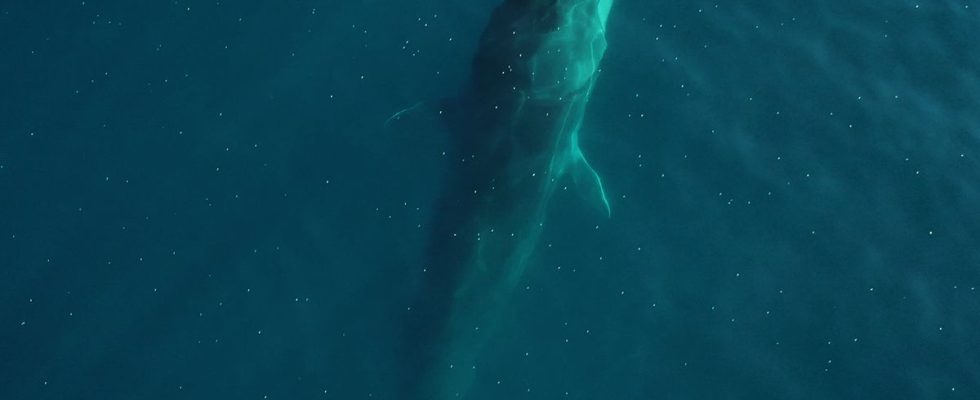Who knows, among those who flock to the shores of the Mediterranean every summer, that the second largest living being in the world, just after the blue whale, splashes offshore, about thirty kilometers away? “Too few people still,” estimates Véronique Andrieux, general director of the WWF France. It must be said that the whale although it may be a colossus that can measure up to 20 meters long and weigh 70 tonnes, it is discreet. Its appearances are rare, this whale spends most of its time at depths of more than 300 meters, in search of krills, these small crustaceans which they love.
To shed a little more light on it and since we only protect what we know, WWF France is devoting a documentary to the whale published this Friday on YouTube. It is the very first film produced by the NGO, and also the very first by wildlife photographer Hugo Hebbe*, who wrote and directed it.
Good news: a stable population
And what better angle of attack than to embark on the Blue Panda, the WWF scientific boat for the Mediterranean, with Denis Ody, responsible for the NGO’s Cetacean program? For twenty years now, the oceanologist, former teammate of Cousteau, has been studying rorquals in the Pelagos sanctuarya protected maritime area located in French, Italian and Monegasque waters.
For 45 minutes, the film oscillates between Denis Ody’s explanations and Hugo Hebbe’s breathtaking images, which take us up close to this giant of the seas, totally harmless to humans. We even dive with it for a few moments, thanks to a miniature camera mounted on a suction cup tag that Denis Ody’s teams place on the animal’s back.
Long hunted, the whale is now a protected species. Although it is not easy to count them, “by combining several methods, we arrive at an estimate of 1,700 individuals in the northwest quarter of the Mediterranean, where it is mainly present,” indicates Denis Ody. In twenty years of observation, the oceanologist has not observed, in any case, any population collapses. “I always meet as many, or even a little more, but it’s also because we have learned to know it and find it,” he says.
A giant that remains fragile in a sea under pressure
From there to say that everything is going well for the whale in the Mediterranean? Not so fast. The cetacean may be a giant, but it is nonetheless exposed to threats in this particularly pressured sea. Plastic pollution is one of them. Every year, 600,000 tonnes flow into the Mediterranean, making it one of the most polluted seas in the world. Invisible offshore, these plastics, which have fragmented into micro-plastics less than 5 mm in size, are there. The whale carries the proof within itself. WWF teams took 250 samples of whale skin and blubber. All contained phthalates, chemical compounds present in many plastics. “At high concentrations, they can greatly weaken the animal’s immune defenses,” assures Gérard Darmon, the voice-over of the documentary. These phthalates are quickly evacuated from the body via urine. That it is found in all the samples would then be a sign of “chronic, continuous and inevitable contamination”, fears WWF France.
Difficult cohabitation with ships
But a more direct threat weighs on the whales: collisions with ships of all kinds that crisscross the Mediterranean. A quarter of global maritime traffic passes through it each year. That is 9,000 boats per day, 220,000 per year. From ferries to LNG tankers, including container ships. And these metal behemoths reach their maximum speed precisely where the fin whale spends most of its life. A statistical study carried out by the WWF made it possible to estimate ship and cetacean collision situations at 3,500 per year… for “only” 8 to 40 fin whales who die each year when struck by these ships, compares Denis Ody. The whale, powerful and fast, therefore manages in the vast majority of cases to dodge these boats, but cannot do everything in the face of their number.
These collisions are the leading cause of unnatural mortality of whales in the Mediterranean. “Until now, dodging was the responsibility of cetaceans and not ships. We must reverse this logic,” argues Denis Ody, who notes some progress. In particular “the creation, last December, of‘a particularly vulnerable maritime area (PSSA), which encompasses the sanctuary of Pelagos and extends to the Spanish coasts in the west.
Reducing speed to ten knots, the solution?
This legal tool of the International Maritime Organization, by which it recognizes the need to protect an area, is still empty. It remains to be given substance through rules ensuring better consideration of marine fauna by maritime traffic. The oceanologist makes ship speed a key parameter in the equation and calls for a limitation of 10 knots (18 km/h) for everyone in this PSSA. “Below, the risk of collisions with animals is very low,” he explains. The game is far from won, but the lines are moving. At least on the cargo side, “which can more easily afford to slow down,” believes Denis Ody. The current context even pushes them in this directionif only to save on increasingly expensive fuel and avoid greenhouse gas emissions.
That leaves ferries, for which a speed limit would have a greater impact on the economic model. For the latter, Denis Ody calls for the creation of “navigation rails”, which ships could use at speeds higher than 10 knots. But to avoid collisions, the head of the WWF Cetaceans program and his teams are working on the development of anti-collision beacons, based on acoustic detection and which would be submerged along these routes. They are capable of detecting whale songs from around twenty kilometers away and, by communicating with each other, would make it possible to precisely locate the cetaceans, says the documentary. It would then remain to alert ships approaching the area to ask them to slow down or deviate their trajectory.

